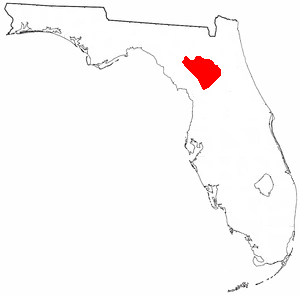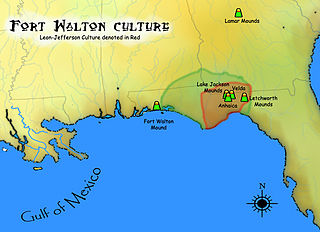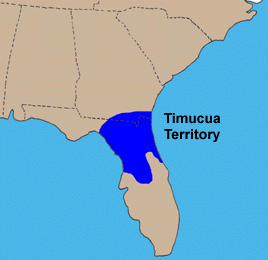
The Apalachee are a Native American people who historically lived in the Florida Panhandle. They lived between the Aucilla River and Ochlockonee River, at the head of Apalachee Bay, an area known to Europeans as the Apalachee Province. They spoke a Muskogean language called Apalachee, which is now extinct.
Tocobaga was the name of a chiefdom, its chief, and its principal town during the 16th century. The chiefdom was centered around the northern end of Old Tampa Bay, the arm of Tampa Bay that extends between the present-day city of Tampa and northern Pinellas County. The exact location of the principal town is believed to be the archeological Safety Harbor Site, which gives its name to the Safety Harbor culture, of which the Tocobaga are the most well-known group.

The Potano tribe lived in north-central Florida at the time of first European contact. Their territory included what is now Alachua County, the northern half of Marion County and the western part of Putnam County. This territory corresponds to that of the Alachua culture, which lasted from about 700 until 1700. The Potano were among the many tribes of the Timucua people, and spoke a dialect of the Timucua language.

Anhaica was the principal town of the Apalachee people, located in what is now Tallahassee, Florida. In the early period of Spanish colonization, it was the capital of the Apalachee Province. The site, now known as Martin Archaeological Site, was rediscovered in 1988.

The Leon-Jefferson Culture is the term used by archaeologists for a protohistoric Native American archaeological culture that flourished in southeastern North America from approximately 1500–1704 CE and is associated with the historic Apalachee people. It was located in and named for the present day Leon and Jefferson counties in northern Florida of the Southeastern United States

Apalachee Province was the area in the Panhandle of the present-day U.S. state of Florida inhabited by the Native American peoples known as the Apalachee at the time of European contact. The southernmost extent of the Mississippian culture, the Apalachee lived in what is now Leon County, Wakulla County and Jefferson County. The name was in use during the early period of European exploration. During Spanish colonization, the Apalachee Province became one of the four major provinces in the Spanish mission system, the others being the Timucua Province,, the Mocama Province and the Guale Province.

Mission San Luis de Apalachee was a Spanish Franciscan mission built in 1633 in the Florida Panhandle, two miles west of the present-day Florida Capitol Building in Tallahassee, Florida. It was located in the descendent settlement of Anhaica capital of Apalachee Province. The mission was part of Spain's effort to colonize the Florida Peninsula and to convert the Timucuan and Apalachee Indians to Christianity. The mission lasted until 1704 when it was evacuated and destroyed to prevent its use by an approaching militia of Creek Indians and South Carolinians.
The Mocama were a Native American people who lived in the coastal areas of what are now northern Florida and southeastern Georgia. A Timucua group, they spoke the dialect known as Mocama, the best-attested dialect of the Timucua language. Their territory extended from about the Altamaha River in Georgia to south of St. Augustine, Florida, covering the Sea Islands and the inland waterways, including the mouth of the St. Johns River in present-day Jacksonville and the Intracoastal. At the time of contact with Europeans, there were two major chiefdoms among the Mocama, the Saturiwa and the Tacatacuru, each of which evidently had authority over multiple villages.

San Joseph de Ocuya was a Spanish Franciscan mission built in the early 17th century in the Florida Panhandle, near the present-day town of Lloyd, Florida. It was part of Spain's effort to colonize the region, and convert the Timucuan and Apalachee Indians to Christianity. The mission lasted until the first decade of the 18th century, when it was destroyed, possibly by Creek Indians and the English.

San Juan de Aspalaga was a Spanish Franciscan mission built in the early 17th century in the Florida Panhandle, near the present-day town of Wacissa, Florida. It was part of Spain's effort to colonize the region, and convert the Timucuan and Apalachee Indians to Christianity. The mission lasted until the first decade of the 18th century, when it was destroyed, possibly by Creek Indians and the English.

Escambe was a Spanish Franciscan mission built in the 17th century in the Florida Panhandle, three miles northwest of the present-day town of Tallahassee, Florida. It was part of Spain's effort to colonize the region, and convert the Timucuan and Apalachee Indians to Christianity. The mission lasted until 1704, when it was destroyed by a group of Creek Indians and South Carolinians.

Beginning in the second half of the 16th century, the Kingdom of Spain established a number of missions throughout La Florida in order to convert the Native Americans to Christianity, to facilitate control of the area, and to prevent its colonization by other countries, in particular, England and France. Spanish Florida originally included much of what is now the Southeastern United States, although Spain never exercised long-term effective control over more than the northern part of what is now the State of Florida from present-day St. Augustine to the area around Tallahassee, southeastern Georgia, and some coastal settlements, such as Pensacola, Florida. A few short-lived missions were established in other locations, including Mission Santa Elena in present-day South Carolina, around the Florida peninsula, and in the interior of Georgia and Alabama.
Acuera was the name of both an indigenous town and a province or region in central Florida during the 16th and 17th centuries. The indigenous people of Acuera spoke a dialect of the Timucua language. In 1539 the town first encountered Europeans when it was raided by soldiers of Hernando de Soto's expedition. French colonists also knew this town during their brief tenure (1564–1565) in northern Florida.

The Timucua were a Native American people who lived in Northeast and North Central Florida and southeast Georgia. They were the largest indigenous group in that area and consisted of about 35 chiefdoms, many leading thousands of people. The various groups of Timucua spoke several dialects of the Timucua language. At the time of European contact, Timucuan speakers occupied about 19,200 square miles (50,000 km2) in the present-day states of Florida and Georgia, with an estimated population of 200,000. Milanich notes that the population density calculated from those figures, 10.4 per square mile (4.0/km2) is close to the population densities calculated by other authors for the Bahamas and for Hispaniola at the time of first European contact. The territory occupied by Timucua speakers stretched from the Altamaha River and Cumberland Island in present-day Georgia as far south as Lake George in central Florida, and from the Atlantic Ocean west to the Aucilla River in the Florida Panhandle, though it reached the Gulf of Mexico at no more than a couple of points.
The indigenous peoples of Florida lived in what is now known as Florida for more than 12,000 years before the time of first contact with Europeans. However, the indigenous Floridians have largely died out with some completely by the early 18th century. Some Apalachees migrated to Louisiana, where their descendants now live; some were taken to Cuba and Mexico by the Spanish in the 18th century, and a few may have been absorbed into the Seminole and Miccosukee tribes.

The Northern Utina, also known as the Timucua or simply Utina, were a Timucua people of northern Florida. They lived north of the Santa Fe River and east of the Suwannee River, and spoke a dialect of the Timucua language known as "Timucua proper". They appear to have been closely associated with the Yustaga people, who lived on the other side of the Suwannee. The Northern Utina represented one of the most powerful tribal units in the region in the 16th and 17th centuries, and may have been organized as a loose chiefdom or confederation of smaller chiefdoms. The Fig Springs archaeological site may be the remains of their principal village, Ayacuto, and the later Spanish mission of San Martín de Timucua.
The Yustaga were a Timucua people of what is now northwestern Florida during the 16th and 17th centuries. The westernmost Timucua group, they lived between the Aucilla and Suwannee Rivers in the Florida Panhandle, just east of the Apalachee people. A dominant force in regional tribal politics, they may have been organized as a loose regional chiefdom consisting of up to eight smaller local chiefdoms.
Benito Ruíz de Salazar Vallecilla was twice governor of Spanish Florida, from 1645 to 1646 and from 1648 to 1651.

B. Calvin Jones was an American archaeologist and discoverer of historic sites in Florida. He is listed as a Great Floridian.












